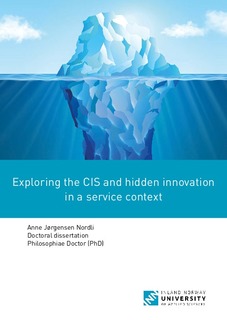Exploring the CIS and hidden innovation in a service context
Abstract
The overall goal of this thesis is to investigate the use of the Community Innovation
Survey (CIS) in a service context. The CIS is a quantitative innovation instrument originally
designed to measure innovation in manufacturing but after some years expanded
to be used for services innovation research also. One objective of this thesis is to
determine whether the CIS is a useful instrument for measuring innovation in services.
Another is to discover more about what the CIS measures and what it may not measure.
The literature points out that some innovation is not identified by the CIS (hidden
innovations). This thesis examines the CIS from different perspectives using tourism as
an empirical service context.
This thesis argues that understanding the processes behind services innovations provides
better insights into the measurement of innovation and hidden innovation; for example,
how innovations start and develop, and who is involved. Such knowledge may reveal
how and why some innovations remain hidden. It is argued that the process of a services
innovation is so crucial to the innovation outcome that it should be acknowledged in
innovation measurement. This thesis addresses how the CIS tends to focus excessively
on innovation output, and it is unclear whether the process that leads to services innovation
is acknowledged. Consequently, this thesis investigates CIS measurement of innovation
and hidden innovation by relating process perspectives on services innovation
to the measurement of the services innovation output.
This thesis uses both quantitative and qualitative methods/designs to investigate and
analyse the research goals. It argues that such combined insights into the phenomenon
will provide a deeper understanding of measurement of innovation and may contribute
to the development of a better measure. Accordingly, this thesis uses a mixed methods
approach to achieve the research goal. The thesis consists of four papers that contribute
to the overall goal of the thesis. Paper 1 is quantitative, Paper 2 is a theoretical and methodological
discussion, and Papers 3 and 4 are qualitative.
The findings of the thesis reveal several examples of hidden innovation and suggest
four different types of hidden innovation. These types follow one of two locally anchored
services innovation processes, and both are categorized as accelerated innovation
processes. One of them is a new type of service innovation process that has not been
addressed in the services innovation literature previously. Additionally, because hidden
innovations follow one of two accelerated processes, they seem to be either unknown,
misinterpreted or forgotten by senior management. The thesis also examines the drivers
of services innovation and how the inclusion of indicators of these drivers in the CIS is
important to reflect distinct activities of the process of services innovation. The thesis
identifies two drivers of CIS-measured innovation—“use of external information” and “use of cross-functional work-teams”—and two drivers of hidden innovation: “formal
and informal evaluation”.
The analysis of the CIS, CIS-measured innovation and hidden innovation suggest that
there are four ways to improve the CIS for use in tourism or similar services in the
future. These four areas of improvement relate to operationalization of the services innovation
concept, respondents’ interpretation of questionnaires and the importance of
including specific driver indicators. First, innovation should not be separated into four
different innovation types as in earlier CIS surveys. Second, it should be clearer in the
CIS that innovation can be a series of incremental changes that together constitute an
innovation. Third, to make it easier for respondents to understand, to interpret and to
answer the survey questions, the language and format should be improved, along with
guidelines about the type of information required in the survey answers. Fourth, the
drivers identified in the thesis should be included in future CIS questionnaires.
In summary, this thesis suggests that the CIS can be used to measure innovation in
tourism and services. The CIS instrument should not be dismissed but rather improved.
One way of improving the instrument for innovation measurement in tourism or similar
services would be to follow the suggested recommendations in this thesis.
